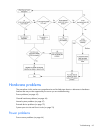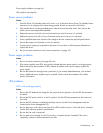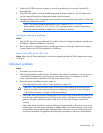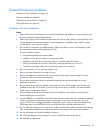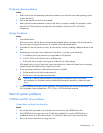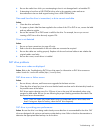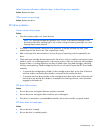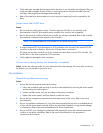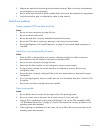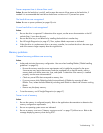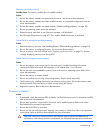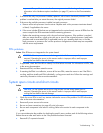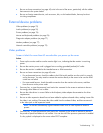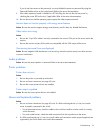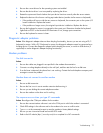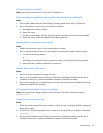5.
Replace any re
for specificatio
quired non-functioning fans and restart the server. Refer to the server documentation
ns on fan requirements.
. Refer to the server documentation for requirements.
ify the fan airflow path is not blocked by cables or other material.
Hard drive pro
2. Be sure no device conflict exists.
rminated if necessary.
sure the SCSI cable is working by replacing it with a known functional cable.
as
1. e hard drive to be sure they indicate normal function. Refer to the server
2. e connections (on page 49) exist.
4. ray controller, be sure the hard drive is configured in an array. Run the array
5. Be sure the drive is properly configured. Refer to the drive documentation to determine the proper
is a non-hot-plug drive, be sure a conflict does not exist with another hard drive. Check for SCSI
Actio
2. er. Run a current version of a virus scan utility.
3. When a TPM is installed and is being used with BitLocker™, be sure the TPM is enabled in RBSU
See the TPM replacement recovery procedure in the
s in the
operating system documentation.
6. Be sure all fan slots have fans or blanks installed
7. Ver
blems
System completes POST but hard drive fails
Action:
1. Be sure no loose connections (on page 49) exist.
3. Be sure the hard drive is properly cabled and te
4. Be
5. Run Insight Diagnostics ("HP Insight Diagnostics" on page 47) and replace failed components
indicated.
Hard drive is not recognized by the server
Action:
Check the LEDs on th
documentation or the HP website for information on hard drive LEDs.
Be sure no loos
3. Remove the hard drive and be sure the configuration jumpers are set properly.
If using an ar
configuration utility.
configuration.
6. If it
ID conflicts.
7. Be sure the correct drive controller drivers are installed.
Data is inaccessible
n:
1. Be sure the files are not corrupt. Run the repair utility for the operating system.
Be sure no viruses exist on the serv
("
HP ROM-Based Setup Utility" on page 47).
operating system documentation.
4. When migrating encrypted data to a new server, be sure to follow the recovery procedure
Troubleshooting 71



